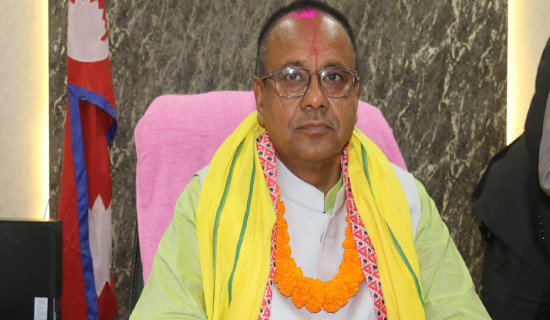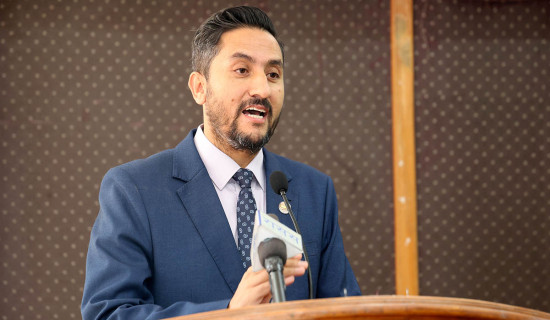- Wednesday, 17 December 2025
Pork Barrel Projects Hurt Public Interest
Powerful politicians and ministers do exercise disproportionate influence in the allocation of national budget in Nepal. This tendency does not limit to one or the other party, one leader or the other leaders but common to all the parties and leaders. This has been known as a global phenomenon especially in the developing world where democratic institutions are weak, and hence democratic values, ethos and norms are undermined and trampled under feet with impunity. During the pre-1990, Panchayat politics period when the monarchy ruled the political roost, siphoning off the resources at the behest of powerful and domineering leaders to serve their own constituencies had been a usual and normal practice.
Such a practice went unquestioned and uncontested. Though the size of the national budget during those days was much lower hovering between 15 billion to 20 billion rupees lesser than the budget size of the present day provinces (Pradesh) that hits around 50 billion rupees in average, powerful ministers and the monarchy loyalists did allocate budget for development projects in their respective constituencies. Late Panchayat leaders like Surya Bahadur Thapa, Dr. Yadav Prasad Pant and then ministers who are in the political spotlight even today like Pashupati Shumsher Rana, Dr. Prakash Chandra Lohani are known for their focus towards nursing their respective constituencies through budget allotment or redeployment of development projects.
Power abuse
During the post-democracy era beginning from 1990 too, political leaders and ministers used or misused their power to appease their constituencies at the cost of rational and judicious distribution of national resources. NC and CPN-UML prime ministers, ministers and lawmakers who held the reins of power had exerted their influence in budget appropriation process to ensure that their districts and areas received greater priority. Former prime minister and Nepali Congress president Sher Bahadur Deuba, former PM and UML chief KP Sharma Oli and many other leaders have been alleged to have focused their undue attention to serve their electoral constituencies through allocation of grandiose schemes and projects.
During the federal republican era too that began institutionally from 2015, prime ministers, ministers and leaders have not eschewed their tendencies to favour the respective constituencies at the expense of balanced national development. As reported in the media, some districts have not received any projects provisioned in the federal spending whereas districts such as Dadeldhura, Gorkha, Nuwakot and Salyan have received huge chunk of resources to implement the pet pork barrel projects through allocations in the national budget for the upcoming year. Needless to say, the districts mentioned above are represented by the powerful politicians and ministers in the incumbent political dispensation where pork barrel projects are allocated in disproportionate way.
The use of the phrase "pork barrel" in referring to dubious government spending dates at least to the second half of the 19th century in the US. The term pork barrel politics usually refers to spending which is intended to benefit constituents of a politician in return for their political support. Pork-barrel politics is characterised by the practice of slipping funding for a local project into a budget. In modern politics, pork-barrelling and earmarking have become virtually synonymous. In Nepal, both earmarking and pork barrelling are excessively used by ministers, lawmakers to fund the projects in their respective constituencies.
Earmarking can be done through line item allocations even in the developed democratic countries but not in the haphazard way we have been practicing in Nepal. Lawmakers both at the federal and provincial levels receive line item budgetary allocations to spend resources on the projects chosen by them which are a sheer waste of tax payer’s money. This is more of a pork barrelling practice which is intended to cater to the interests of the voters for a particular constituency.
An NGO keeping vigil on the practices of the pork barrel projects in the US defines it as a line item in an appropriations bill that designates tax payer’s money (dollars) for a specific purpose while circumventing established budgetary procedures. In fact, references to pork barrel projects were common in Congress, and the term was further popularised by a 1919 article by Chester Collins Maxey in the National Municipal Review, which reported on certain legislative acts known to members of Congress as "pork barrel bills". He claimed that the phrase originated in a pre-Civil War practice of giving slaves a barrel of salted pork as a reward and requiring them to compete among themselves to get their share of the hand-out.
Dubious value
It has been discussed that the phrase was derived from the time when enslaved people would scramble for their shares of salted pork, which people who owned slaves gave to them in barrels as a reward. The pork barrel projects do not need to undergo a competitive bidding process and refers funding for questionable projects in their home districts for gains to be accrued by political leader. Pork barrel spending has thus come to mean spending on public works projects of dubious value in exchange for political support, often at the expense of the interests of the broader public.
While it wasn't yet called pork barrel spending, Thomas Jefferson – the third president of the US who was among the authors of the American constitution, condemned the practice in a letter to James Madison in 1796, calling it a “source of boundless patronage to the executive” and a “bottomless abyss of public money”. In Nepal, earmarking the line item budget for nursing the lawmaker’s constituency and pork barrelling are widely criticised in the media but the practice has not been discontinued even as the country has been reorganised into federal set up and local governments have been strengthened to cater to the local needs.
(The author is presently associated with Policy Research Institute (PRI) as a senior research fellow. rijalmukti@gmail.com.)
















